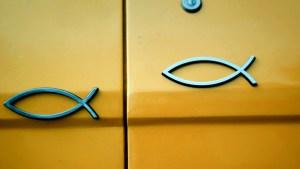Lenten Campaign 2025
This content is free of charge, as are all our articles.
Support us with a donation that is tax-deductible and enable us to continue to reach millions of readers.
When thinking about Christian art, dolphins don’t immediately come to mind. Yet, in the ancient world dolphins were viewed quite differently.
They were known as the “sailor’s friend” and there are many legends of dolphins leading mariners to safer shores. As a result, dolphins were seen as a good omen to those at sea, and their mysterious character found their way into Greek mythology. In classical art, dolphins are often seen giving rides to both mortals and gods, and were the special messengers of Poseidon. The temple at Delphi may have received its name in connection to the legend that Apollo came to the sanctuary in the shape of a dolphin.
By the early centuries of Christianity dolphins had great meaning in the pagan world and so naturally the symbol was quickly adopted — and converted — by Christians.
For those who made a living by the sea dolphins became a symbol of Jesus Christ, a friend and deliverer to the “safer shores” of heaven. According to Mike Aquilina in his book Signs and Mysteries: Revealing Ancient Christian Symbols, there is even a dolphin in the catacombs “with an exposed heart.”
Most often dolphins are drawn twisted around an anchor or trident, as in the catacombs of Villa Torlonia in Rome, symbolizing the hope of eternal life.
In other places dolphins represent Christians, similar to how fish can be used in Christian art to represent those who follow Christ.

Read more:
Why do Christians use the fish symbol?
So it turns out the dolphin is one of the most used sea creatures in the iconography of the Christian catacombs and has a depth of meaning that is astonishing.

